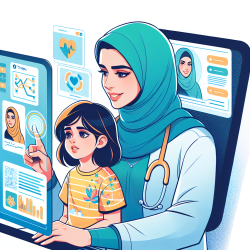Introduction
The COVID-19 pandemic has significantly reshaped healthcare delivery, particularly for pediatric feeding disorders (PFD), which require a multidisciplinary approach. A recent study, "Interdisciplinary feeding clinic during the coronavirus disease 2019 pandemic: Implementing telehealth and social determinants of health screening," highlights how telehealth and social determinants of health (SDH) screening can be effectively integrated into PFD management.
The Shift to Telehealth
The transition to telehealth was necessitated by the pandemic, allowing continued care for children with PFD. The study found that telehealth not only maintained the quality of care but also improved access, particularly for younger children. Data showed that 68% of scheduled visits were attended via telehealth, indicating a positive reception among families.
Telehealth offers several advantages:
- Improved access to care, especially for families in remote areas.
- Reduced no-show rates and increased patient portal activation.
- Enhanced family-centered care by allowing simultaneous provider-family interactions.
However, challenges such as technological barriers and socioeconomic disparities remain. Addressing these issues requires ongoing support and training for both staff and families to ensure equitable access to telehealth services.
Implementing Social Determinants of Health Screening
SDH screening was introduced to identify and address social and economic factors impacting health. The study utilized an adapted SDH screening tool focusing on domains such as food, housing, and education. Results indicated that over 50% of families required support in areas like childcare and food.
Integrating SDH screening into routine care can:
- Identify at-risk families and connect them with necessary resources.
- Enhance understanding of the broader context affecting child health.
- Inform policy and practice improvements to better support families.
Despite its benefits, the study noted limitations, including the exclusive use of public insurance data and the need for more comprehensive SDH domains.
Implications for Practitioners
Practitioners can enhance their skills by adopting telehealth and SDH screening in their practice. Key steps include:
- Providing training for staff and families to navigate telehealth platforms effectively.
- Utilizing SDH screening tools to identify and address social risk factors.
- Collaborating with community resources to support families' needs.
By embracing these strategies, practitioners can improve care delivery and outcomes for children with PFD, particularly in underserved communities.
Conclusion
The integration of telehealth and SDH screening in managing PFD during the pandemic has demonstrated significant benefits. Continued research and adaptation are essential to address existing disparities and optimize care. Practitioners are encouraged to explore these approaches further to enhance their practice and support the well-being of children and families.
To read the original research paper, please follow this link: Interdisciplinary feeding clinic during the coronavirus disease 2019 pandemic: Implementing telehealth and social determinants of health screening.










